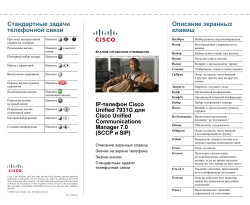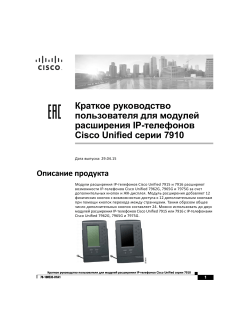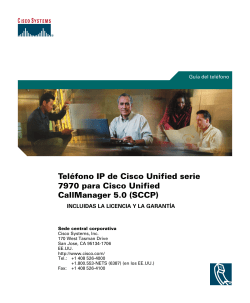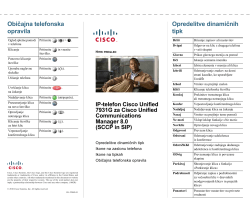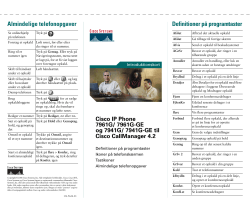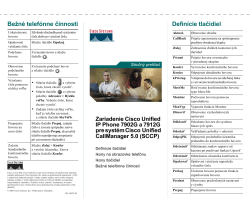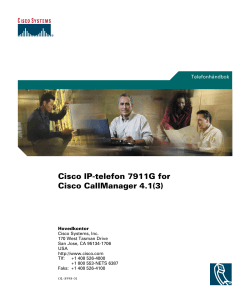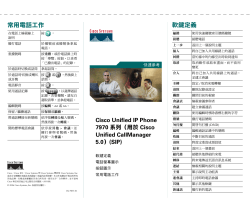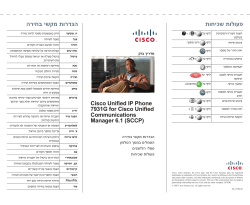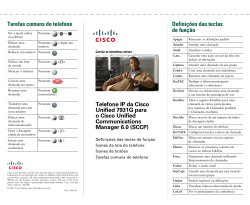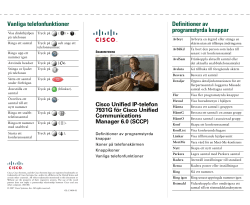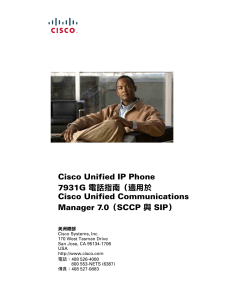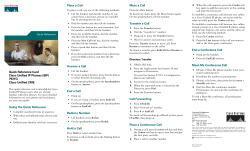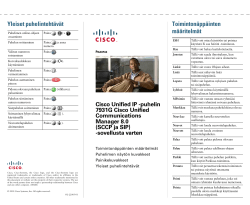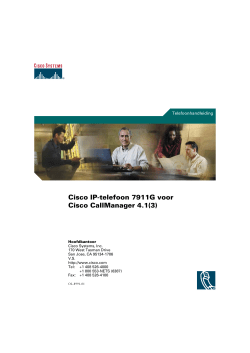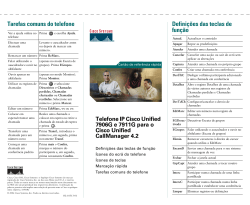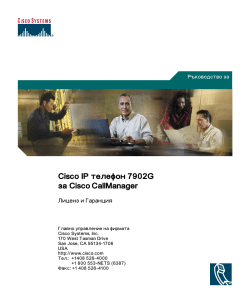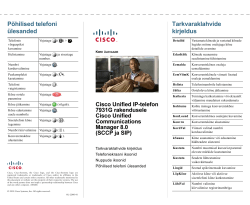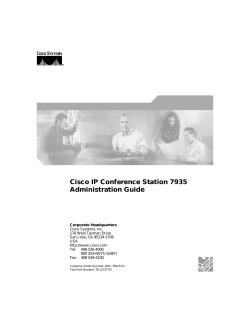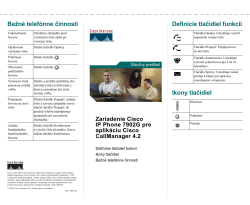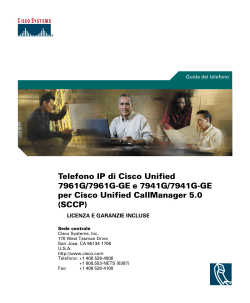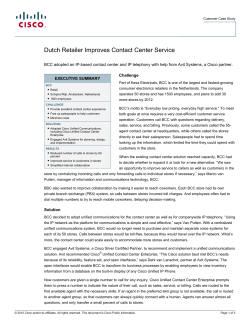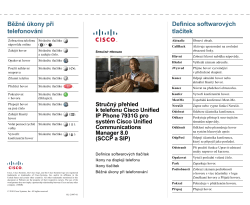Скачать
Штаб-квартира корпорации
Cisco Systems, Inc.
170 West Tasman Drive
San Jose, CA 95134-1706
USA
http://www.cisco.com
Тел.: +1 408 526-4000
+1 800 553-NETS (6387)
Факс: +1 408 526-4100
IP-телефон Cisco 7961G/7961G-GE
и 7941G/7941G-GE для
Cisco CallManager 4.1(3)
СОДЕРЖИТ ЛИЦЕНЗИЮ И ГАРАНТИЮ
Руководство по
эксплуатации телефона
Руководство по эксплуатации телефона
-
Contents
-
Table of Contents
-
Troubleshooting
-
Bookmarks
Quick Links
Cisco Unified IP Phone 7931G
User Guide for Cisco Unified
Communications Manager 8.5(1)
(SCCP and SIP)
Americas Headquarters
Cisco Systems, Inc.
170 West Tasman Drive
San Jose, CA 95134-1706
USA
http://www.cisco.com
Tel:
408 526-4000
800 553-NETS (6387)
Fax:
408 527-0883
Related Manuals for Cisco CP-7931G
Summary of Contents for Cisco CP-7931G
-
Page 1
Cisco Unified IP Phone 7931G User Guide for Cisco Unified Communications Manager 8.5(1) (SCCP and SIP) Americas Headquarters Cisco Systems, Inc. 170 West Tasman Drive San Jose, CA 95134-1706 http://www.cisco.com Tel: 408 526-4000 800 553-NETS (6387) Fax: 408 527-0883… -
Page 3: Table Of Contents
Placing a Call—Basic Options Placing a Call—Additional Options Answering a Call Ending a Call Using Hold and Resume Using Mute Switching Between Multiple Calls Cisco Unified IP Phone 7931G Phone Guide for Cisco Unified Communications Manager 8.5(1) (SCCP and SIP)
-
Page 4
Using BLF to Determine a Line State Making and Receiving Secure Calls Tracing Suspicious Calls Prioritizing Critical Calls Using Cisco Extension Mobility Managing Business Calls Using a Single Phone Number Using a Handset, Headset, and Speakerphone Using a Handset Using a Headset… -
Page 5
Understanding Additional Configuration Options Troubleshooting Your Phone General Troubleshooting Viewing Phone Administration Data Using the Quality Reporting Tool Cisco One-Year Limited Hardware Warranty Terms Index Cisco Unified IP Phone 7931G Phone Guide for Cisco Unified Communications Manager 8.5(1) (SCCP and SIP) -
Page 6
OL-22334-01… -
Page 7: Getting Started
Listen to your voice messages Accessing Voice Messages, page See softkey and icon definitions Refer to the Quick Reference Card in the front of this guide. Cisco Unified IP Phone 7931G Phone Guide for Cisco Unified Communications Manager 8.5(1) (SCCP and SIP)
-
Page 8: Finding Additional Information
Depending on the quality of these devices and their proximity to other devices such as mobile phones or two-way radios, some audio noise can still occur. In these cases, Cisco recommends that you take one or more of these actions: •…
-
Page 9: Cisco Product Security Overview
Getting Started Cisco cannot guarantee the performance of the system because Cisco has no control over the quality of external devices, cables, and connectors. The system will perform adequately when suitable devices are attached using good quality cables and connectors.
-
Page 10
OL-22334-01… -
Page 11: Connecting Your Phone
IP telephony network. If that is not the case, refer to the graphic and table below to connect your phone. 10/100 SW 10/100 PC DC48V Cisco Unified IP Phone 7931G Phone Guide for Cisco Unified Communications Manager 8.5(1) (SCCP and SIP)
-
Page 12
DC Adaptor port (DC48V) (optional) Network port (10/100 SW) Access port (10/100 PC) Headset port Handset port Adjusting the Handset Rest When you connect your phone, you may want to adjust the handset rest to ensure that the receiver will not slip out of the cradle. -
Page 13
Beyond the physical, mechanical and technical performance, the audio portion of a headset must sound good to the user and to the party on the far end. Sound quality is subjective and Cisco cannot guarantee the performance of any headsets However, a variety of headsets from leading headset manufacturers have been reported to perform well with Cisco Unified IP Phones. -
Page 14
OL-22334-01… -
Page 15: An Overview Of Your Phone
• A comprehensive online help system that displays information on the phone screen. Understanding Buttons and Hardware You can use the graphic below to identify buttons and hardware on your phone. Cisco Unified IP Phone 7931G Phone Guide for Cisco Unified Communications Manager 8.5(1) (SCCP and SIP)
-
Page 16
OL-22334-01… -
Page 17
BLF status, or active Mobile Connect call) Red, flashing—Remote call on hold Line keys are numbered 24 to 1 in descending order, alternating from left to right. Cisco Unified IP Phone 7931G Phone Guide for Cisco Unified Communications Manager 8.5(1) (SCCP and SIP) -
Page 18
Messages, page 65 there is a message waiting. Phone screen Displays information such as line/call status, phone Understanding Phone number, and soft key tabs. Screen Features, page 15 Cisco Unified Shows the Cisco Unified IP Phone model number. IP Phone model OL-22334-01… -
Page 19: Understanding Lines And Calls
14). • Calls—Each line can support a single call. If multiple lines share a directory number, each line can still support one call each. Cisco Unified IP Phone 7931G Phone Guide for Cisco Unified Communications Manager 8.5(1) (SCCP and SIP)
-
Page 20: Understanding Line And Call Icons
Understanding Line and Call Icons Your phone displays icons to help you determine the line and call state and feature accessibility on each line. Icon Line or call state Description Call State On-hook line No call activity on this line. Off-hook line You are dialing a number or an outgoing call is ringing.
-
Page 21: Understanding Phone Screen Features
If not, remove the blank one and make your own labels. Understanding Phone Screen Features This is what your phone screen may look like when idle. This view is called “Overview.” Cisco Unified IP Phone 7931G Phone Guide for Cisco Unified Communications Manager 8.5(1) (SCCP and SIP)
-
Page 22
Date and time Displays the current date and time. display Primary phone Displays the phone number (directory number) for your primary phone line. line Programmable Programmable buttons can serve as phone line buttons, intercom line button buttons, speed-dial buttons, phone service buttons, call feature buttons, or local indicators feature buttons. -
Page 23: Accessing The Application Menu
You can access features using softkeys or pressing a line key. You can configure some of these features, but your system administrator controls most of them. Cisco Unified IP Phone 7931G Phone Guide for Cisco Unified Communications Manager 8.5(1) (SCCP and SIP)
-
Page 24: Understanding Sip Vs. Sccp
Here are some details about using softkeys and line buttons to access features. Feature Softkey Line Button Label and Icon CallBack CallBack CallBack Call Forward CFwdALL Forward All Call Park Park Park Call PickUp PickUp PickUp Conference Confrn Conference Conference List ConfList Conference List Do Not Disturb…
-
Page 25: Basic Call Handling
(if available) from your Placed Calls log. This is called Auto Dial. To call a number displayed with Auto Dial, scroll to it and go off-hook or press the Select button. Cisco Unified IP Phone 7931G Phone Guide for Cisco Unified Communications Manager 8.5(1) (SCCP and SIP)
-
Page 26: Placing A Call-Additional Options
Corporate Directory (name can vary). 2. Enter a name and press Search. 3. Highlight a listing and go off-hook. Use Cisco CallBack to receive 1. Press CallBack while listening to the Your system notification when a busy or busy tone or ring sound.
-
Page 27
4. Press 1 to make a call to an enterprise IP phone. 5. Dial a desktop phone number other than your desktop phone number. Cisco Unified IP Phone 7931G Phone Guide for Cisco Unified Communications Manager 8.5(1) (SCCP and SIP) -
Page 28
For more information, If you want to… Then… see… Place a call using Fast Dial Note Before using this option, your Configuring Fast Dials on system administrator must the Web, page 69 configure this feature and assign a Using Your Personal service URL to the line button. -
Page 29: Answering A Call
Calls, page 40 Use your phone to answer Use Call Pickup. Picking Up a Redirected Call a call ringing elsewhere on Your Phone, page 39 Cisco Unified IP Phone 7931G Phone Guide for Cisco Unified Communications Manager 8.5(1) (SCCP and SIP)
-
Page 30: Ending A Call
If you want to… Then… For more information, see… Answer a priority call Hang up the current call and Prioritizing Critical Calls, press Answer. page 46 Answer a call on your Set up Mobile Connect and answer Managing Business Calls mobile phone or other your phone.
-
Page 31: Using Mute
• Your system administrator determines the duration between Hold Reversion alerts. • The Hold feature is disabled on a Call Chaperone user’s Cisco Unified IP Phone when the calls are being chaperoned. Using Mute With Mute enabled, you can hear other parties on a call but they cannot hear you.
-
Page 32: Switching Between Multiple Calls
The number of seconds to answer the call on your desk phone is set by your system administrator. The other Cisco Unified devices that share the same line display a Remote in Use message. The number of seconds to resume the call depends on the configuration set by the system administrator.
-
Page 33: Transferring Calls
Press Resume to remove the call from hold before transferring it. • The Transfer feature is disabled on a Call Chaperone user’s Cisco Unified IP Phone when the calls are being chaperoned. Cisco Unified IP Phone 7931G Phone Guide for Cisco Unified Communications Manager 8.5(1) (SCCP and SIP)
-
Page 34: Sending A Call To A Voice-Message System
You can also ask your system administrator to configure a longer time-out value. • When you switch an in-progress call from your mobile phone to Cisco Unified devices that share the same line (Session Handoff), the iDivert feature is disabled on the Cisco Unified devices. The iDivert feature returns when the call ends.
-
Page 35: Forwarding Calls To Another Number
Coverage)—Applies to certain calls that you receive, according to conditions. You can access Call Forward All on your phone or from your Cisco Unified CM User Options web pages; conditional call forwarding features are accessible only from your User Options web pages.
-
Page 36: Using Do Not Disturb
• When you switch an in-progress call from your mobile phone to Cisco Unified devices that share the same line (Session Handoff), the Call Forward feature is disabled on the Cisco Unified devices.
-
Page 37: Making Conference Calls
“None” (to use the “Alert” setting configured by your system administrator). Making Conference Calls Your Cisco Unified IP Phone allows you to join three or more people into one telephone conversation, creating a conference call. Using Conference Features You can create a conference in various ways, depending on your needs and the features that are available on your phone.
-
Page 38: Using Conference
Using Conference Conference allows you to call each participant. Conference is available on most phones. If you want to… Then… Create a conference by calling 1. From a connected call, press Confrn or Conference. (You may participants need to press the more softkey to see Confrn.) 2.
-
Page 39: Using Join
Join to complete the action. • When Join completes, caller ID changes to “Conference.” Cisco Unified IP Phone 7931G Phone Guide for Cisco Unified Communications Manager 8.5(1) (SCCP and SIP)
-
Page 40
Using Meet-Me Meet-Me conferencing allows you to start or join a conference by calling the conference number. If you want to… Then… Start a Meet-Me conference 1. Obtain a Meet-Me phone number from your system administrator. 2. Distribute the number to participants. 3. -
Page 41: Viewing Or Removing Conference Participants
• Talk to the caller by pressing the active intercom button and using either the handset, headset or speaker. The intercom call becomes a two-way connection so that you can converse with the caller. Cisco Unified IP Phone 7931G Phone Guide for Cisco Unified Communications Manager 8.5(1) (SCCP and SIP)
-
Page 42
• When your active call is being monitored or recorded, you can receive or place intercom calls. • You cannot place an intercom call on hold. If you log into the same phone on a daily basis using your Cisco Extension Mobility profile, Note… -
Page 43: Advanced Call Handling
1. Set up Abbreviated Dialing codes. See Setting Up Speed Dials on the Web, Dialing page (On-hook) 2. To place a call, enter the Abbreviated Dialing code and press AbbrDial. Cisco Unified IP Phone 7931G Phone Guide for Cisco Unified Communications Manager 8.5(1) (SCCP and SIP)
-
Page 44
If you want to… Then… Use Abbreviated 1. Pick up the handset. Dialing 2. Press the AbbrDial softkey and enter the abbreviated dial code using (Off-hook) the keypad. 3. Press the AbbrDial softkey again. To use Off-hook Abbreviated Dialing to conference a call: 1. -
Page 45: Picking Up A Redirected Call On Your Phone
• If you have multiple lines and want to pick up the call on a non-primary line, first press the desired line and then press a Call PickUp softkey or button. Cisco Unified IP Phone 7931G Phone Guide for Cisco Unified Communications Manager 8.5(1) (SCCP and SIP)
-
Page 46: Storing And Retrieving Parked Calls
Call Park number and press Transfer again. • Assisted Directed Call Park—Use the Assisted Directed Call Park button displaying an idle line status indicator. To retrieve the call from any other Cisco Unified IP Phone in your network, press the flashing Assisted Direct Call Park button.
-
Page 47: Logging Out Of Hunt Groups
Press HLog . When logged in, the Hunt Group button is lit. group calls Logging out of hunt groups does not prevent non-hunt group calls from ringing your phone. Cisco Unified IP Phone 7931G Phone Guide for Cisco Unified Communications Manager 8.5(1) (SCCP and SIP)
-
Page 48: Using A Shared Line
If you are sharing a line with coworkers using a different model Cisco Unified IP Phone, they might be able to add (or barge) themselves to your active call on the shared line. Your phone does not typically support this feature.
-
Page 49: Using Blf To Determine A Line State
See the state of a line Look for BLF indicators next to the line number: listed in a call log or Line is in-use. directory Line is idle. Cisco Unified IP Phone 7931G Phone Guide for Cisco Unified Communications Manager 8.5(1) (SCCP and SIP)
-
Page 50: Making And Receiving Secure Calls
If you want to… Then… See the state of a Look for BLF indicators next to the line number: speed-dial line Line is in-use. Line is idle. BLF- monitored line is ringing (BLF Pickup) Use BLF Pickup to While the line is ringing, press the BLF Pickup button answer a call ringing on The call is redirected to the next available line on your phone.
-
Page 51
There are interactions, restrictions, and limitations that affect how security features work on Note your phone. For more information, ask your system administrator. Cisco Unified IP Phone 7931G Phone Guide for Cisco Unified Communications Manager 8.5(1) (SCCP and SIP) -
Page 52: Tracing Suspicious Calls
A device engaged in a call is either trusted or untrusted as determined by Cisco. Lock or shield Note icons are not displayed on a Cisco Unified IP Phone screen when a call is to or from an untrusted device, even though the call may be secure.
-
Page 53: Using Cisco Extension Mobility
– Using Cisco Extension Mobility Cisco Extension Mobility (EM) allows you to configure a Cisco Unified IP Phone as your own temporarily. Once you log in to EM, the phone adopts your user profile, including your phone lines, features, established services, and web-based settings. Your system administrator must configure EM for you.
-
Page 54
• EM automatically logs you out after a certain amount of time. Your system administrator establishes this time limit. • Changes that you make to your EM profile from your Cisco Unified CM User Options web pages take effect immediately if you are logged in to EM on the phone; otherwise, changes take effect the next time you log in. -
Page 55: Managing Business Calls Using A Single Phone Number
2. On your mobile phone, press the Resume (name may vary) softkey on the mobile phone. See Switching an In-Progress Call to Another Phone, page Cisco Unified IP Phone 7931G Phone Guide for Cisco Unified Communications Manager 8.5(1) (SCCP and SIP)
-
Page 56
If you want to… Then… Connect to Mobile Voice 1. From any phone, dial your assigned Mobile Voice Access number. Access 2. Enter the number you are calling from, if prompted, and your PIN. Turn on Mobile Connect 1. Dial your assigned Mobile Voice access number. from your mobile phone 2. -
Page 57
Mobile Voice Access call disconnects, and you are locked out for a period of time. Contact your system administrator if you need assistance. Cisco Unified IP Phone 7931G Phone Guide for Cisco Unified Communications Manager 8.5(1) (SCCP and SIP) -
Page 58
OL-22334-01… -
Page 59: Using A Handset, Headset, And Speakerphone
Press the Volume button during a call or after invoking a dial tone. call Press Save to preserve the volume level for future calls. Cisco Unified IP Phone 7931G Phone Guide for Cisco Unified Communications Manager 8.5(1) (SCCP and SIP)
-
Page 60: Using A Speakerphone
If you use AutoAnswer, see Using AutoAnswer with a Headset or Speakerphone, page 55. Using Wideband with your Headset If you use a headset that supports wideband, you may experience improved audio sensitivity if you enable the wideband setting on your phone (this setting is disabled by default). To access the setting, choose ) >…
-
Page 61: Using Autoanswer With A Headset Or Speakerphone
Keep the handset in the cradle and headset mode inactive ( speakerphone unlit). Otherwise, calls ring normally and you must answer them manually. AutoAnswer is disabled when the Do Not Disturb feature is active. Cisco Unified IP Phone 7931G Phone Guide for Cisco Unified Communications Manager 8.5(1) (SCCP and SIP)
-
Page 62
OL-22334-01… -
Page 63: Changing Phone Settings
Options Web Pages, page 67.) sounds on your phone 2. Access your message indicator settings. (See Controlling Line Settings on the Web, page 74.) Cisco Unified IP Phone 7931G Phone Guide for Cisco Unified Communications Manager 8.5(1) (SCCP and SIP)
-
Page 64: Customizing The Phone Screen
You can customize your phone to have up to six distinctive ring tones. In addition, you can have a default ring tone. Customizing the Phone Screen You can adjust the characteristics of the phone screen. If you want to… Then… Change the phone 1.
-
Page 65: Using Call Logs And Directories
Erase a single call 1. Choose > Directories > Missed Calls, Placed Calls, or Received record Calls. 2. Highlight a call record. 3. Press Delete. Cisco Unified IP Phone 7931G Phone Guide for Cisco Unified Communications Manager 8.5(1) (SCCP and SIP)
-
Page 66
If you want to… Then… Dial from a call log 1. Choose > Directories > Missed Calls, Placed Calls, or (while not on Received Calls. another call) 2. Highlight a call record. If the Details softkey appears, the call is the primary entry of a multiparty call. -
Page 67: Directory Dialing
Directory is comprised of Personal Address Book (PAB) and Fast Dials: PAB is a directory of your personal contacts. – Fast Dials allows you to assign codes to PAB entries for quick dialing. – Cisco Unified IP Phone 7931G Phone Guide for Cisco Unified Communications Manager 8.5(1) (SCCP and SIP)
-
Page 68: Using Corporate Directory On Your Phone
Using Corporate Directory on Your Phone You can use a corporate directory to place calls to coworkers. If you want to… Then… Dial from a corporate 1. Choose > Directories > Corporate Directory (exact name directory (while not on can vary). another call) 2.
-
Page 69: Using Personal Directory On Your Phone
5. Choose Phones and use the keypad to enter phone numbers. Be sure to include any necessary access codes such as a 9 or 1. 6. Choose Submit to add the entry to the database. Cisco Unified IP Phone 7931G Phone Guide for Cisco Unified Communications Manager 8.5(1) (SCCP and SIP)
-
Page 70
If you want to… Then… Assign a Fast Dial 1. Search for a PAB entry. code to a PAB entry 2. Highlight the listing and press Select. 3. Press Fast Dial. 4. Highlight the number that you want to dial and press Select. 5. -
Page 71: Accessing Voice Messages
Send a call to a voice Press iDivert. For more information, see Sending a Call to a Voice-Message message system System, page Cisco Unified IP Phone 7931G Phone Guide for Cisco Unified Communications Manager 8.5(1) (SCCP and SIP)
-
Page 72
OL-22334-01… -
Page 73: Using The User Options Web Pages
Using the User Options Web Pages Your Cisco Unified IP Phone is a network device that can share information with other network devices in your company, including your personal computer. You can use your computer to log in to your Cisco Unified CM User Options web pages, where you can control features, settings, and services for your Cisco Unified IP Phone.
-
Page 74: Configuring Features And Services On The Web
The Personal Directory feature set that you can access on your computer consists of: • A Personal Address Book (PAB) • Fast Dials • Cisco Unified Communications Manager Address Book Synchronizer You can also access the PAB and Fast Dials from your phone. See Using Personal Directory on Your…
-
Page 75: Configuring Fast Dials On The Web
2. Click Add New. (without using a 3. Change the Fast Dial code, if desired. PAB entry) 4. Enter a phone number. 5. Click Save. Cisco Unified IP Phone 7931G Phone Guide for Cisco Unified Communications Manager 8.5(1) (SCCP and SIP)
-
Page 76: Using The Address Book Synchronization Tool
If you want to… Then do this after you log in… Search for a 1. Choose User Options > Fast Dials. Fast Dial entry 2. Specify search information and click Find. Edit a Fast Dial 1. Choose User Options > Fast Dials. phone number 2.
-
Page 77: Setting Up Speed Dials On The Web
Configuring Fast Dials on the Web, page You can also set up Fast Dials on your phone. See Using Personal Directory on Your Phone, page Cisco Unified IP Phone 7931G Phone Guide for Cisco Unified Communications Manager 8.5(1) (SCCP and SIP)
-
Page 78: Setting Up Phone Services On The Web
Setting Up Phone Services on the Web Phone services can include special phone features, network data, and web-based information (such as stock quotes and movie listings). You must first subscribe to a phone service before accessing it on your phone. If you want to…
-
Page 79: Controlling User Settings On The Web
3. Click Save. Change your PIN 1. Choose User Options > User Settings. 2. In the Phone PIN area, enter information. 3. Click Save. Cisco Unified IP Phone 7931G Phone Guide for Cisco Unified Communications Manager 8.5(1) (SCCP and SIP)
-
Page 80: Controlling Line Settings On The Web
Your PIN and password allow you to access different features and services. For example, use your PIN to log in to Cisco Extension Mobility or Personal Directory on your phone. Use your password to log in to your User Options web pages and Cisco WebDialer on your personal computer. For more information, ask your system administrator.
-
Page 81
Typically, the default message-waiting setting prompts your phone to display a steady red light from the handset light strip to indicate a new voice message. 6. Click Save. Cisco Unified IP Phone 7931G Phone Guide for Cisco Unified Communications Manager 8.5(1) (SCCP and SIP) -
Page 82
If you want to… Then do this after you log in… Change the audible 1. Choose User Options > Device. voice message indicator 2. From the Name menu, choose a phone. setting per line 3. Click Line Settings. 4. If you have more than one directory number (line) assigned to your phone, choose a line from the Line menu. -
Page 83: Setting Up Phones And Access Lists For Mobile Connect
Setting Up Phones and Access Lists for Mobile Connect When using Cisco Mobile Connect, you must add your mobile and other phones that you want to use to make and receive calls using the same directory numbers as your desk phone. These phones are called remote destinations.
-
Page 84
If you want to… Then do this after you log in… Add a new remote 1. Choose User Options > Mobility Settings > Remote Destinations. destination 2. Click Add New. 3. Enter the following information: Name—Enter a name for the mobile (or other) phone. –… -
Page 85
Smart Client Installed—Select to indicate that the remote destination – you are setting up is a smartphone. 6. Click Save. Cisco Unified IP Phone 7931G Phone Guide for Cisco Unified Communications Manager 8.5(1) (SCCP and SIP) -
Page 86: Using Cisco Webdialer
Using Cisco WebDialer Cisco WebDialer allows you to make calls on your Cisco Unified IP Phone to directory contacts by clicking items in a web browser. Your system administrator must configure this feature for you. If you want to… Then…
-
Page 87
Make Call page. This page appears by default after you click a phone number in a WebDialer-enabled online directory. • Disable Auto Close—If selected, the call window does not close automatically after fifteen seconds. Cisco Unified IP Phone 7931G Phone Guide for Cisco Unified Communications Manager 8.5(1) (SCCP and SIP) -
Page 88
OL-22334-01… -
Page 89: Understanding Additional Configuration Options
Request a shared line. This allows you Using a Shared Line, page extension for several to use one extension for your desk phones phone and lab phone, for example. Cisco Unified IP Phone 7931G Phone Guide for Cisco Unified Communications Manager 8.5(1) (SCCP and SIP)
-
Page 90
Using Cisco Extension • • A shared line to view coworkers’ Mobility, page calls. • Cisco Extension Mobility to apply your phone number and user profile to a shared Cisco Unified IP Phone. Answer calls frequently Ask your system administrator to set… -
Page 91: Troubleshooting Your Phone
All loop or would exceed the maximum number of links permitted in a Call Call Forward All Forward All chain (also known as a maximum hop count). Ask your system administrator for details. Cisco Unified IP Phone 7931G Phone Guide for Cisco Unified Communications Manager 8.5(1) (SCCP and SIP)
-
Page 92: Viewing Phone Administration Data
Viewing Phone Administration Data Your system administrator may ask you to access administration data on your phone for troubleshooting purposes. If you are asked to… Then… Access network Choose ) > Settings > Network Configuration and select the configuration data network configuration item that you want to view.
-
Page 93: Cisco One-Year Limited Hardware Warranty Terms
Your formal Warranty Statement, including the warranties and license agreements applicable to Cisco software, is available on Cisco.com at this URL: http://www.cisco.com/en/US/docs/general/warranty/English/1Y1DEN__.html Cisco Unified IP Phone 7931G Phone Guide for Cisco Unified Communications Manager 8.5(1) (SCCP and SIP)
-
Page 94
OL-22334-01… -
Page 95: Index
DND erasing Cisco Extension Mobility viewing and dialing from Cisco Unified IP Phone 7931G Phone Guide for Cisco Unified Communications Manager 8.5(1) (SCCP and SIP)
-
Page 96
Cisco Unified Communications Manager Address Book Synchronizer Cisco Unified IP Phone troubleshooting encrypted calls web-based services for ending a call, options for Cisco Unified Video Advantage Extension Mobility Cisco WebDialer Client Matter Code, see CMC 21, 85 conference calls 21, 85… -
Page 97
Personal Address Book Personal Address Book, see PAB Personal Directory using from web page Malicious Call Identification using on phone MCID phone lines Cisco Unified IP Phone 7931G Phone Guide for Cisco Unified Communications Manager 8.5(1) (SCCP and SIP) -
Page 98
description of security, for calls phone screen services, subscribing to adjusting contrast shared lines changing language and remote-in-use icon illumination setting description of phone services, configuring softkey buttons PIN, changing speakerphone placed calls, records of answering calls with placing calls, options for hanging up with 19, 20 pre-dial… -
Page 99
WebDialer whisper Cisco Unified IP Phone 7931G Phone Guide for Cisco Unified Communications Manager 8.5(1) (SCCP and SIP) -
Page 100
OL-22334-01… -
Page 101
Cisco has more than 200 offices worldwide. Addresses, phone numbers, and fax numbers are listed on the Cisco Website at www.cisco.com/go/offices. Cisco and the Cisco Logo are trademarks of Cisco Systems, Inc. and/or its affiliates in the U.S. and other countries. A listing of Cisco’s trademarks can be found at www.cisco.com/go/trademarks .
This manual is also suitable for:
7931g
Краткое содержание страницы № 1
Cisco Unified IP Phone 7931G
User Guide for Cisco Unified
Communications Manager 8.5(1)
(SCCP and SIP)
Americas Headquarters
Cisco Systems, Inc.
170 West Tasman Drive
San Jose, CA 95134-1706
USA
http://www.cisco.com
Tel: 408 526-4000
800 553-NETS (6387)
Fax: 408 527-0883
Краткое содержание страницы № 2
Краткое содержание страницы № 3
Contents Getting Started 1 Using this Guide 1 Finding Additional Information 2 Safety and Performance Information 2 Cisco Product Security Overview 3 Accessibility Features 3 Connecting Your Phone 5 An Overview of Your Phone 9 Understanding Buttons and Hardware 9 Understanding Lines and Calls 13 Understanding Line and Call Icons 14 Understanding Phone Screen Features 15 Accessing the Application Menu 17 Accessing the Help System on Your Phone 17 Understanding Featur
Краткое содержание страницы № 4
Switching an In-Progress Call to Another Phone 26 Transferring Calls 27 Sending a Call to a Voice-Message System 28 Forwarding Calls to Another Number 29 Using Do Not Disturb 30 Making Conference Calls 31 Using Conference Features 31 Viewing or Removing Conference Participants 35 Placing or Receiving Intercom Calls 35 Advanced Call Handling 37 Speed Dialing 37 Picking Up a Redirected Call on Your Phone 39 Storing and Retrieving Parked Calls 40 Logging Out of Hunt Grou
Краткое содержание страницы № 5
Customizing the Phone Screen 58 Using Call Logs and Directories 59 Using Call Logs 59 Directory Dialing 61 Using Corporate Directory on Your Phone 62 Using Personal Directory on Your Phone 63 Accessing Voice Messages 65 Using the User Options Web Pages 67 Accessing Your User Options Web Pages 67 Configuring Features and Services on the Web 68 Using Personal Directory on the Web 68 Setting Up Speed Dials on the Web 71 Setting Up Phone Services on the Web 72 Controlling
Краткое содержание страницы № 6
vi OL-22334-01
Краткое содержание страницы № 7
Getting Started Using this Guide This guide provides you with an overview of the features available on your phone. You can read it completely for a solid understanding of your phone’s capabilities or refer to the table below for pointers to commonly used sections. If you want to… Then Explore your phone on your own Press ( ) > on the phone when you need assistance. Review important safety information See Safety and Performance Information, page 2. Connect your phone See Connecting Your
Краткое содержание страницы № 8
Finding Additional Information • You can access the most current Cisco Unified IP Phone documentation at this URL: http://www.cisco.com/en/US/products/hw/phones/ps379/tsd_products_support_series_home.html � You can access the Cisco website at this URL: http://www.cisco.com/ � You can access the most current Licensing Information at this URL: http://www.cisco.com/en/US/docs/voice_ip_comm/cuipph/all_models/openssl_license/ 7900_ssllic.html � Cisco international websites: Allows access to in
Краткое содержание страницы № 9
Getting Started Cisco cannot guarantee the performance of the system because Cisco has no control over the quality of external devices, cables, and connectors. The system will perform adequately when suitable devices are attached using good quality cables and connectors. Caution In European Union countries, use only external speakers, microphones, and headsets that are fully compliant with the EMC Directive [89/336/EC]. Cisco Product Security Overview This product contains cryptographic f
Краткое содержание страницы № 10
4 OL-22334-01
Краткое содержание страницы № 11
Connecting Your Phone Your system administrator will likely connect your new Cisco Unified IP Phone to the corporate IP telephony network. If that is not the case, refer to the graphic and table below to connect your phone. 10/100 SW 10/100 PC DC48V 1 5 4 2 3 Cisco Unified IP Phone 7931G Phone Guide for Cisco Unified Communications Manager 8.5(1) (SCCP and SIP) 5 170686
Краткое содержание страницы № 12
1 DC Adaptor port (DC48V) (optional) Network port (10/100 SW) 2 3 Access port (10/100 PC) Headset port 4 5 Handset port Adjusting the Handset Rest When you connect your phone, you may want to adjust the handset rest to ensure that the receiver will not slip out of the cradle. See the table below for instructions. 1 2 3 1 Set the handset aside and pull the square plastic tab from the handset rest. Rotate the tab 180 degrees. 2 3 Slide the tab back into the handset rest. An extension protrudes
Краткое содержание страницы № 13
Connecting Your Phone Headset Support Although Cisco Systems performs limited internal testing of third-party headsets for use with the Cisco Unified IP Phones, Cisco does not certify or support products from headset or handset vendors. Cisco recommends the use of good quality external devices, for example headsets that are screened against unwanted radio frequency (RF) and audio frequency (AF) signals. Depending on the quality of these devices and their proximity to other devices such as
Краткое содержание страницы № 14
8 OL-22334-01
Краткое содержание страницы № 15
An Overview of Your Phone The Cisco Unified IP Phone 7931G is a full-feature telephone that provide voice communication over the same data network that your personal computer uses, which allows you to place and receive phone calls, put calls on hold, transfer calls, make conference calls, and so on. It is designed to meet the communication needs with moderate telephone traffic and specific call requirements. It provides you with dedicated hold, redial, and transfer keys to facilitate call h
Краткое содержание страницы № 16
. 14 10 OL-22334-01
Краткое содержание страницы № 17
An Overview of Your Phone For more information, Item Description see… Programmable Depending on configuration, programmable � Understanding 1 buttons buttons (or line keys) provide access to: Phone Screen Features, page 15 � Phone lines and intercom lines (line buttons) � Basic Call � Speed-dial numbers (speed-dial buttons, Handling, page 19 including the BLF speed-dial feature) � Speed Dialing, � Web-based services (for example, a Personal page 37 Address Book button) � Using
Краткое содержание страницы № 18
For more information, Item Description see… Paper label Allows you to identify each button with line or Understanding Line 2 feature information. and Call Icons, page 14 3 Softkey buttons Each activates a softkey option (displayed on your Understanding Phone phone screen). Screen Features, page 15 4 Hold button Places calls on hold. Using Hold and Resume, page 24 5 Transfer button Connects a call to another number. Transferring Calls, page 27 6 Redial button Connects to the last dialed
Краткое содержание страницы № 19
An Overview of Your Phone For more information, Item Description see… 4-way Navigation button Understanding Phone 15 navigation pad Screen Features, � Scroll up and down to see menus and highlight and Select page 15 items button (center) � Scroll left to open the Details view and see directory numbers and features assigned to each line button (when on call screen) � Scroll right to close the Details view Select button—scroll to select a line using the Understanding Phone Navigation
Краткое содержание страницы № 20
Understanding Line and Call Icons Your phone displays icons to help you determine the line and call state and feature accessibility on each line. Icon Line or call state Description Call State On-hook line No call activity on this line. Off-hook line You are dialing a number or an outgoing call is ringing. Connected call You are connected to the other party. Call Forwarding Call forwarding is enabled on this line. enabled Ringing call A call is ringing on one of your lines, or a BLF- monitor
-
manualzz.com
- Computers & electronics
- Telecom & navigation
- IP phones
Инструкции и Руководства для Cisco Cisco Unified IP Phone 7931G.
Мы нашли 32
инструкции доступные для бесплатного скачивания:
Инструкция по применению, Руководство пользователя
Cisco Cisco Unified IP Phone 7931G Ip Phone User Guide
Бренд:
Cisco
Размер:
347 KB
Страниц:
20
Язык(и):
Русский
Открыть в новой вкладке
Cisco Cisco Unified IP Phone 7931G Ip Phone User Guide
Бренд:
Cisco
Размер:
410 KB
Страниц:
2
Язык(и):
Русский
Открыть в новой вкладке
Cisco Cisco Unified Wireless IP Phone 7925G-EX Ip Phone User Guide
Бренд:
Cisco
Размер:
297 KB
Страниц:
16
Язык(и):
Русский
Открыть в новой вкладке
Cisco Cisco Unified IP Phone 7931G Ip Phone User Guide
Бренд:
Cisco
Категория:
IP phones
Размер:
2 MB
Страниц:
118
Язык(и):
Немецкий
Открыть в новой вкладке
Cisco Cisco Unified IP Phone 7931G Ip Phone User Guide
Бренд:
Cisco
Размер:
1 MB
Страниц:
80
Язык(и):
Испанский
Открыть в новой вкладке
Cisco Cisco Unified IP Phone 7931G Ip Phone User Guide
Бренд:
Cisco
Размер:
267 KB
Страниц:
2
Язык(и):
Словенский
Открыть в новой вкладке
Cisco Cisco Unified IP Phone 7931G Ip Phone Quick Reference Card
Бренд:
Cisco
Размер:
123 KB
Страниц:
2
Язык(и):
Датский
Открыть в новой вкладке
Cisco Cisco Unified IP Phone 7931G Ip Phone Overview
Бренд:
Cisco
Размер:
252 KB
Страниц:
2
Язык(и):
Словацкий
Открыть в новой вкладке
Cisco Cisco Unified IP Phone 7931G Ip Phone Leaflet
Бренд:
Cisco
Размер:
926 KB
Страниц:
56
Язык(и):
Датский
Открыть в новой вкладке
Cisco Cisco Unified IP Phone 7931G Ip Phone Leaflet
Бренд:
Cisco
Размер:
262 KB
Страниц:
2
Язык(и):
Японский, zh
Открыть в новой вкладке
Cisco Cisco Unified IP Phone 7931G Ip Phone User Guide
Бренд:
Cisco
Размер:
343 KB
Страниц:
2
Язык(и):
Иврит
Открыть в новой вкладке
Cisco Cisco Unified IP Phone 7931G Ip Phone Quick Reference Card
Бренд:
Cisco
Размер:
133 KB
Страниц:
2
Язык(и):
Датский
Открыть в новой вкладке
Cisco Cisco Unified IP Phone 7931G Ip Phone User Guide
Бренд:
Cisco
Размер:
141 KB
Страниц:
2
Язык(и):
Португальский
Открыть в новой вкладке
Cisco Cisco Unified IP Phone 7931G Ip Phone Quick Reference Card
Бренд:
Cisco
Размер:
98 KB
Страниц:
2
Язык(и):
Датский
Открыть в новой вкладке
Cisco Cisco Unified IP Phone 7931G Ip Phone User Guide
Бренд:
Cisco
Размер:
142 KB
Страниц:
2
Язык(и):
Шведский
Открыть в новой вкладке
Cisco Cisco Unified IP Phone 7931G Ip Phone User Guide
Бренд:
Cisco
Размер:
488 KB
Страниц:
2
Язык(и):
Испанский
Открыть в новой вкладке
Cisco Cisco Unified IP Phone 7931G Ip Phone User Guide
Бренд:
Cisco
Размер:
141 KB
Страниц:
2
Язык(и):
Голландский
Открыть в новой вкладке
Cisco Cisco Unified IP Phone 7931G Ip Phone User Guide
Бренд:
Cisco
Размер:
2 MB
Страниц:
86
Язык(и):
Японский, zh
Открыть в новой вкладке
Cisco Cisco Unified IP Phone 7931G Ip Phone User Guide
Бренд:
Cisco
Размер:
60 KB
Страниц:
2
Язык(и):
Английский
Открыть в новой вкладке
Cisco Cisco Unified IP Phone 7931G Ip Phone User Guide
Бренд:
Cisco
Размер:
148 KB
Страниц:
2
Язык(и):
Эстонский
Открыть в новой вкладке
Cisco Cisco Unified Wireless IP Phone 7925G-EX Ip Phone Instruction Manual
Бренд:
Cisco
Размер:
731 KB
Страниц:
60
Язык(и):
Голландский
Открыть в новой вкладке
Cisco Cisco Unified IP Phone 7975G Ip Phone Reference Guide
Бренд:
Cisco
Размер:
146 KB
Страниц:
2
Язык(и):
Португальский
Открыть в новой вкладке
Cisco Cisco Unified IP Phone 7961G-GE Ip Phone Leaflet
Бренд:
Cisco
Размер:
796 KB
Страниц:
28
Язык(и):
Болгарский
Открыть в новой вкладке
Cisco Cisco Unified IP Phone 7911G Ip Phone User Guide
Бренд:
Cisco
Размер:
217 KB
Страниц:
2
Язык(и):
Эстонский
Открыть в новой вкладке
Cisco Cisco Unified IP Phone Expansion Module 7916 Ip Phone Quick Reference Card
Бренд:
Cisco
Размер:
249 KB
Страниц:
2
Язык(и):
Румынский
Открыть в новой вкладке
Cisco Cisco Unified IP Phone 7971G-GE Ip Phone Maintenance Manual
Бренд:
Cisco
Категория:
IP phones
Размер:
934 KB
Страниц:
94
Язык(и):
Английский
Открыть в новой вкладке
Cisco Cisco Unified Wideband Handset Ip Phone Overview
Бренд:
Cisco
Размер:
189 KB
Страниц:
2
Язык(и):
Словацкий
Открыть в новой вкладке
Cisco Cisco Unified IP Phone Expansion Module 7914 Ip Phone Quick Setup Guide
Бренд:
Cisco
Размер:
244 KB
Страниц:
2
Язык(и):
Боснийский, Хорватский
Открыть в новой вкладке
Cisco Cisco Unified Wireless IP Phone 7925G-EX Ip Phone User Manual
Бренд:
Cisco
Размер:
1 MB
Страниц:
84
Язык(и):
Итальянский
Открыть в новой вкладке
Cisco Cisco Unified Wireless IP Phone 7921G Multicharger Ip Phone Information Guide
Бренд:
Cisco
Размер:
290 KB
Страниц:
3
Язык(и):
Английский
Открыть в новой вкладке
Cisco Cisco Unified IP Phone 7906G Ip Phone User Guide
Бренд:
Cisco
Размер:
282 KB
Страниц:
2
Язык(и):
Словацкий
Открыть в новой вкладке
Cisco Cisco Unified IP Phone 7931G Ip Phone Guida utente
Бренд:
Cisco
Размер:
2 MB
Страниц:
100
Язык(и):
Итальянский
Открыть в новой вкладке
Содержание
- Настройка телефона Cisco серии 79XX для работы с Asterisk
- Используется:
- Настройка
- Что не вошло в статью
- Subnets.ru blog
- Перепрошивка и настройка VoIP телефона Cisco 7931G
Настройка телефона Cisco серии 79XX для работы с Asterisk
В статье будут описаны нюансы настройки IP-телефона Cisco на примере цискофона 7942G.
Итак, если вы присматриваетесь к VoIP-устройствам Cisco серии 79XX, то добро пожаловать под кат.
Используется:
Cisco VoIP Phone 7942G
Asterisk 1.4.39
TFTP-server-0.49
Внимание! Инструкция подходит не для всех телефонов Cisco 79XX. См. здесь
Настройка
Комбинации клавиш в Cisco
**#** — перезагрузка телефона (через меню)
**# — разблокировка настроек (также через меню). Разблокировка нужна, например, для того чтобы поставить настройки DHCP-клиента
Смена прошивки
Итак, сначала нужно разыскать нужную прошивку для работы по SIP, т.к. по умолчанию используется версия с SCCP. Для этого есть гугл или торренты.
Далее заходим на известный всем сайт voip-info.org. По ссылке выложена информация о прошивке. Т.к. у меня версия астериска 1.4 (которая не умеет работать по tcp), то советуют брать версию 8.5.4. По этой ссылке есть много и другой полезной информации.
Таким образом, нам нужен файл cmterm-7942_7962-sip.8-5-4.zip. Все файлы которые там есть нужно вывалить в корень тфтп-сервера.
Русская локаль
Еще бы нам не помешала русская локаль. Ну т.е. чтобы все надписи на экране были на русском языке.
Я её брал из файла po-locale-ru_RU-8.4.3.1000-1.exe (тоже можно найти в интернете). Тут есть одна хитрость — при запуске программы она вываливает ошибку и потом закрывается. Но нам ведь всего лишь нужны файлы локали, установить мы их можем и сами.
Поэтому после запуска идем в папку %TEMP% (советую предварительно её очистить) и смотрим что там программа вывалит.
Там в числе прочего будет папка Russian_Russian_Federation. Вот её нам и нужно будет поместить в корень tftp-сервера.
Версия локали будет как раз 8.4.3.1000-1.
Файл кофигурации цискофона
Теперь перейдем непосредственно к файлу конфигурации. Цискофон загружает его исключительно с tftp-сервера. Сначала кажется неудобно, с другой стороны, нужно настроить всего один раз, а затем можно эти телефоны хоть штабелями закупать — настройка их будет аналогичной и займет минимум времени. Кроме того, этим Cisco обезопасил телефон от «шаловливых ручек» пользователей. Через меню сделать практически ничего нельзя.
Файл должен называться SEP .cnf.xml.
Мак-адрес записан на тыльной стороне устройства.
Определим некоторые значения:
$ASTERISK — ай-пи нашего астериска
$SERVICESURL — полный путь до скрипта, который генерирует адресную книгу (например, 192.168.0.22/asterisk/directory.php)
$ACCOUNT — пользователь/номер нашего аккаунта на астериске. Если у вас нет соответствия номер пользователь, то конфиг нужно будет соответствующим образом поменять.
$ACCOUNT_PASS — пароль от SIP-аккаунта
Теперь будем комментировать.
Все часовые пояса можно найти, например, здесь.
Следующие настройки нужны для настройки локали:
Конфигурация sip.conf астериска
Самое интересное здесь — call-limit=2. Суть в том, что можно будет получать 1 или 2 звонка (3 звонок уже на циску не пойдет — зачем её напрягать?), их можно обрабатывать на телефоне, переключаясь между ними. Больше чем 2 звонка в этом аппарате не поддерживается (возможно будет поддерживаться в новых прошивках), хотя обрабатывать 3 звонка уже достаточно накладно.
Настройка диалплана цискофона
Циско настолько умная, что может использовать свой собственный диалплан. Но тут есть обратная сторона медали. Если этот диалплан не указать, то исходящие звонки вообще ходить не будут. Точней будут, но только на номера от 0 до 9 =).
В этом конфиге мы по сути передаем всю ответственность на астериск — т.е. просто после 3-х секунд передаем номер. Более изящные номерные планы можно найти на voip-info.org.
Адресная книга абонентов
У нас есть LDAP (в связке с samba), в нем есть информация о телефонах пользователей. Так почему бы этим не воспользоваться?
Сервер LDAP, filter поиска нужно будет поменять на свои настройки.
directory.php:
Обновление. Заметьте, что на странице только 32 контакта. Почему так? Не знаю, чем это объяснить, но так реализовано в прошивке — больше чем 32 контакта не поддерживается. Впрочем, это не беда, т.к. можно реализовать при помощи софткеев механизм отображения пред. и след. страниц.
Делаем настройки для логотипа
Для начала по логам tftp смотрим куда cisco обращается за картинкой. Происходит это в момент выбора фонового изображения
через меню телефона (как разблокировать меню написано выше).
изображения из меню
/tftpboot/Desktops/320x196x4/List.xml:
Нам нужно создать одну картинку 320×196 и одну картинку в 4 раза меньше (80×49).
Logo-TN.png — эскиз.
Logo.png — полноценная картинка.
Изменять логотип нужно через меню телефона.
Что не вошло в статью
— Настройка сигналов вызовов. Да, это тоже можно делать. Другое дело — зачем? Если для вас оно имеет смысл — то дерзайте.
— Настройка directories. Есть возможность, например, читать RSS с телефона и вообще добавлять различные контент-каталоги.
Источник
Subnets.ru blog
Сети, настройка оборудования, сетевые сервисы.
|
||||||
| Subnets.ru Регистрация IP и Автономных систем mega-net.ru |
Перепрошивка и настройка VoIP телефона Cisco 7931G
Возникла необходимость настроить телефон Cisco Unified IP Phone 7931G для работы по протоколу SIP и подключению его к серверу с Asterisk.
Ранее я не имела опыта по настройке данных аппаратов и пришлось разбираться с нуля.
Итак у нас имеется аппарат, который штатно работает по протоколу SCCP (Skinny Client Control Protocol, проприетарный протокол Cisco).
Первостепенная задача — перепрошить телефон SIP прошивкой, взятой с официального сайта.
На сайте есть прошивка версии 9+ и я сначала поставила ее, но возникли проблемы с конфигом. Примеров конфигурационного файла для 9ой версии в Инете не нашлось и телефон отказывался работать (даже с сокращенным до минимума конфигом для прошивок версии 
Для настройки телефона нам понадобится:
В моем случае — все делалось на рабочей станции под OS FreeBSD.
IP-адрес машины для внутренней сети — 10.20.1.1/24
Если вдруг Ваш телефон не настроен на DHCP, то это можно изменить через меню телефона. Надо разблокировать возможность менять настройки комбинацией клавиш **#, и, покопавшись в не сильно просторном меню, выставить искомый параметр.
Для запуска tftp требуется расскоментировать (или добавить) строчку в /etc/inetd.conf
tftp dgram udp wait root /usr/libexec/tftpd tftpd -s /tftpboot
Создать директорию в корне (если она отсутствует):
#mkdir /tftpboot
Установить права доступа на эту директорию:
#chown -R nobody:nogroup /tftpboot
Далее запустить
#/etc/rc.d/inetd onestart
Для автозапуска, после перезагрузки системы, добавить в /etc/rc.conf:
inetd_enable=”YES”
Проверяем, запустился ли демон inetd:
#sockstat | grep :69
root inetd 1094 5 udp4 *:69 *:*
Настраиваем DHCP. Установила из портов сервер isc-dhcp42-server:
#cd /usr/ports/net/isc-dhcp42-server/
#make install clean
Далее правим конфиг DHCP и добавляем DHCP Option 66 и Option 150:
#ee /usr/local/etc/dhcpd.conf
Cisco Systems использует нестандартную опцию в DHCP – option 150 (проприетарная опция) для настройки своих аппаратов. Опция 66 — ее аналог.
Тоже самое можно сделать и на микротике, для этого в настройки DHCP сервера нужно добавить:
/ip dhcp-server option
add code=66 name=tftp66 value=»‘IP tftp‘»
add code=150 name=tftp150 value=»‘IP tftp’”
Где IP tftp это IP-адрес нашего TFTP сервера. Пишем его в одинарных кавычках, если добавлять через винбокс, а если через консоль, то в одинарных, а потом в двойных.
/ip dhcp-server network
add address=Network/mask dhcp-option=tftp66,tftp150 dns-server=DNS1,DNS2 gateway=IP-router netmask=24
В папку /tftpboot выкладываем файлы из скаченного архива с прошивкой.
Список файлов:
- SIP31.8-5-3SR1S.loads
- apps31.8-5-3ES4.sbn
- cnu31.8-5-3ES4.sbn
- cvm31sip.8-5-3ES4.sbn
- dsp31.8-5-3ES4.sbn
- jar31sip.8-5-3ES4.sbn
- term31.default.loads
На этом приготовления окончены и мы приступаем к самому процессу.
Необходимо удалить с телефона старую прошивку. Для этого:
- отключаем телефон от питания
- включаем держа клавишу # до тех пор пока программируемые кнопки не начнут мигать по очереди оранжевым светом
- отпускаем кнопку и вводим на телефоне код: 3491672850*#
Телефон должен начать мигать кнопками, красным цветом. Это значит процесс стирания старой прошивки пошел. Затем телефон выключается и визуально не видно, делает ли он что-либо. Следует спокойно подождать 3-5 минут.
А пока я смотрела в tcpdump трафика на интерфейсе в сторону телефона и логи tftp-сервера, чтобы убедиться что есть обращения от телефона к DHCP и получения файлов по TFTP.
Итак телефон прошился новой прошивкой и загружается. Для его дальнейшей работы в /tftpboot нам требуется создать конфигурационный файл телефона в формате XML, который должен иметь название вида: SEP000000000000.cnf.xml
Где 000000000000 – МАС-адрес телефона, который написан на нем на наклейке сзади.
Содержимое конфигурационного файла (наиболее интересные строки, на которые стоит обратить внимание, выделены синим):
Следует отметить, что если телефон не принимает конфигурационный файл, например из-за наличия ошибок в нем, то он будет отображать на экране состояние «Unprovisioned» и каждые 30 секунд обращаться к tftp-серверу, пытаясь вновь скачать конфигурационный файл (вдруг, на этот раз он не будет содержать ошибок). Эти попытки прекрасно видны по tcpdump`у и в логах TFTP.
Для проверки корректности XML синтаксиса конфигурационного файла мне дали хороший совет: просто открыть файл конфига браузером. Лично мне это помогло, помогло осознать почему конфиг не принимается, а так же браузер точно указал в каком именно месте ошибка синтаксиса.
Пробежимся по настройкам:
dateTemplate — формат День — Месяц — Год.
timeZone — Временные зоны, например, перечислены тут
loadInformation — Версия прошивки, которую брать. Должно совпадать с названием файла .loads
phoneLabel — в правом верхнем углу будет висеть этот лейбл. Не длинее 12 символов.
preferredCodec — голосовой кодек, который будет использовать телефон
webAccess — Включение WEB-сервера на телефона. Обратите внимание, что для включение веб-интерфейса необходимо установить значение параметра в ноль.
sshAccess — Тоже самое касается ssh доступа на устройство.
Причем основная часть инструкций считает достаточным ввести 2 строки с UserID и Password для работы сервиса ssh, некоторые источники указывают еще верхние 2, и поясняют их актуальность только для версий прошивки старше 8.5.1. У меня не получилось подключиться по ssh ни в одном из найденных мной версий написания этих параметров.
Настройки сети:
registerWithProxy — для регистрации SIP линий
natEnable — ставим «true» если телефон находится за NAT
Если natEnable в «true», то телефону необходимо знать внешний IP-адрес NAT`а. Для этого есть две опции:
- natReceivedProcessing — внешний IP-адрес будет автоматически браться из поля VIA (received=XXX.XXX.XXX.XXX) SIP-пакета 200 ОК полученный от сервера в ответ на пакет REGISTER от телефона, вместо поля Contact
- natAddress — явное указание внешнего IP адрес NAT`a
При работе за NAT`ом выбрала установку natReceivedProcessing, а natAddress оставила пустым:
Указание диапазона RTP портов:
voipControlPort — если значение пустое, то по умолчанию порт 5060. Обратите внимание, что в зависимости от значения параметра natEnabled поведение разное.
Если natEnabled «false», то этот порт используется в кач-ве SRC порта для отправки SIP пакетов. Если natEnabled «true», то телефон будет отправлять пакеты с непривилегированных портов, а на этом порту будет ожидать ОТВЕТЫ от SIP-сервера.
Таким образом, при установке телефона за NAT и без дополнительной настройки шлюза (проброс порта) он работать не будет.
Изыскания на эту тему написаны в топике «Cisco 7931g SIP» на forum.asterisk.ru:
После чего телефон утверждает udp port 49287 unreachable:
Снова попробовал через NAT и наконец разобрался.
Могу сказать, что в предыдущий раз, это я ОЛЕНЬ (правда не пойму как так получилось), но судя по дампу, и наличию «rport» в конце строки VIA на которую я не обратил внимания, в пире в этот момент точно стояло nat=yes, а не nat=no.
Установил nat=no на стороне Asterisk, в конфиге телефона:
И… и это не взлетело, но на этот раз причина ясна:
- 1.1.68.16 — Asterisk
- 1.1.68.72 — IPшник NAT`а
- 10.10.1.153 — IPшник телефона
Прохождение пакета REGISTER от телефона: 10.10.1.153.49845 > 1.1.68.72.49845 > 1.1.68.16.5060 (поле Contact: )
Прохождение ответного пакета 401 Unauthorized: 1.1.68.16.5060 > 1.1.68.72.5061
Пакет доезжает до 1.1.68.72, но не проходит к 10.10.1.153 т.к. в таблице NAT трансляций отсутствует запись о 10.10.1.153:5061, т.к. изначальный пакет 10.10.1.153.49845, посему пакет просто отбрасывается.
Соответственно становится логично, что если сделать проброс порта 5061 с внешнего 1.1.68.72 на 10.10.1.153, то все конечно же заработает.
Делаем проброс 5061 и ч.т.д.
Дамп на стороне Asterisk`а:
7896/7896 1.1.68.72 D 5061 Unmonitored
Reg. Contact : sip:7896@1.1.68.72:5061;transport=udp
Дамп на стороне NAT`а (после процесса NAT):
SIP линии:
featureID — про этот параметр ниже
proxy- IP-адрес нашего сервера c Asterisk
port — SIP порт
name — Имя или номер SIP аккаунта
displayName — Отображаемое имя, соответственно указываем или имя или номер.
authName — имя вашего аккаунта для авторизации на сервере, обычно это ваш номер
authPassword — пароль вашего SIP аккаунта
contact — номер SIP аккаунта
Линия с Speed Dial
SD (Speed Dial — набор номера по нажатии кнопки) на программируемых кнопках (коих 24 штуки).
Хотелось настроить еще и BLF, но это оказалось все непросто с этим на этом телефоне. Идея была отодвинута (отлично гуглятся решения, вроде работы телефона с Cisco Call Manager), т.к. необходимо пропатчить Астериск, а именно chan_sip.
Кнопки линий пронумерованы от 24 до 1 сверху вниз, чередуясь слева вправо. Соответвенно, 1 линия находится в правом нижнем углу.
featureLabel- выводимое описание
speedDialNumber — номер для набора
featureID — код фичи, то что будет делаться по нажатию кнопки:
- feature id 1 last number redial
- feature id 2 speed dial
- feature id 3 hold
- feature id 5 fwd all
- feature id 9 line — Для SIP регистрации
- feature id 19 private
- feature id 20 service uri
- featureid 21 speed dial — Для набора сохраненного номера
- feature id 22 paging
- feature id 27 Malicious call ID
Источник



